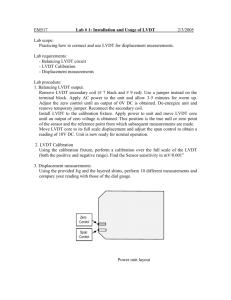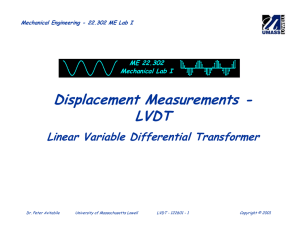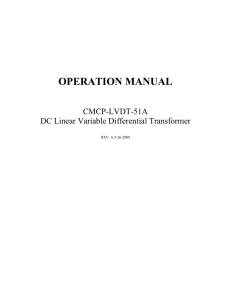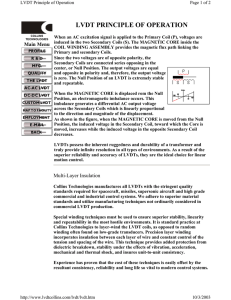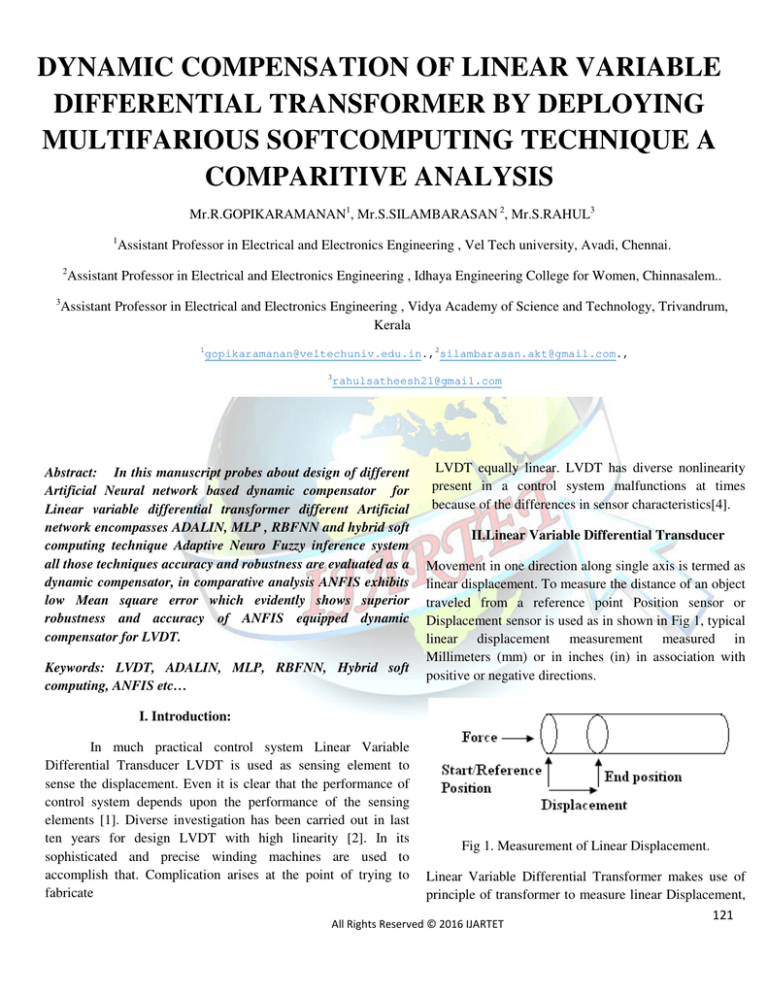
DYNAMIC COMPENSATION OF LINEAR VARIABLE
DIFFERENTIAL TRANSFORMER BY DEPLOYING
MULTIFARIOUS SOFTCOMPUTING TECHNIQUE A
COMPARITIVE ANALYSIS
Mr.R.GOPIKARAMANAN1, Mr.S.SILAMBARASAN 2, Mr.S.RAHUL3
1
2
3
Assistant Professor in Electrical and Electronics Engineering , Vel Tech university, Avadi, Chennai.
Assistant Professor in Electrical and Electronics Engineering , Idhaya Engineering College for Women, Chinnasalem..
Assistant Professor in Electrical and Electronics Engineering , Vidya Academy of Science and Technology, Trivandrum,
Kerala
1
gopikaramanan@veltechuniv.edu.in.,2silambarasan.akt@gmail.com.,
3
rahulsatheesh21@gmail.com
Abstract: In this manuscript probes about design of different
Artificial Neural network based dynamic compensator for
Linear variable differential transformer different Artificial
network encompasses ADALIN, MLP , RBFNN and hybrid soft
computing technique Adaptive Neuro Fuzzy inference system
all those techniques accuracy and robustness are evaluated as a
dynamic compensator, in comparative analysis ANFIS exhibits
low Mean square error which evidently shows superior
robustness and accuracy of ANFIS equipped dynamic
compensator for LVDT.
Keywords: LVDT, ADALIN, MLP, RBFNN, Hybrid soft
computing, ANFIS etc…
LVDT equally linear. LVDT has diverse nonlinearity
present in a control system malfunctions at times
because of the differences in sensor characteristics[4].
II.Linear Variable Differential Transducer
Movement in one direction along single axis is termed as
linear displacement. To measure the distance of an object
traveled from a reference point Position sensor or
Displacement sensor is used as in shown in Fig 1, typical
linear displacement measurement measured in
Millimeters (mm) or in inches (in) in association with
positive or negative directions.
I. Introduction:
In much practical control system Linear Variable
Differential Transducer LVDT is used as sensing element to
sense the displacement. Even it is clear that the performance of
control system depends upon the performance of the sensing
elements [1]. Diverse investigation has been carried out in last
ten years for design LVDT with high linearity [2]. In its
sophisticated and precise winding machines are used to
accomplish that. Complication arises at the point of trying to
fabricate
Fig 1. Measurement of Linear Displacement.
Linear Variable Differential Transformer makes use of
principle of transformer to measure linear Displacement,
121
All Rights Reserved © 2016 IJARTET
core and coil assembly vitally constitutes LVDT core is
held over the object whose position is being to measure
while coil assembly mounted on stationary frame.
Hallow form wounded by wire wound by three coils
constitutes coil assembly. Primary is contributed by
Permeable core material that slides freely along the
center of inner coil energized by an AC source and an
AC voltage in every coil.
phase in every secondary.Direction, distance and its
amplitude are determined by phase of the upshot signal.
Cross-sectional view of an LVDT is depicted in Fig 3.
Effect of Magnetic field is generated Due to the cause of
magnetic field coupling between primary winding and
secondary’s ,Between the primary and secondary when
the core centered and poised as depicted in Fig 3 as
given, developed voltage in every secondary is in par and
rational in amplitude and 180 deg out of phase.
Eventually Voltage output of the LVDT is zero owing to
the cancel of equally induced voltages mutually[5].
Fig 2 General LVDT Assembly
The focal advantage of LVDT transducer amid existing
other type of transducer is aristocratic decree of
robustness and preciseness owing to no physical contact
along the sensing element that gives rise to no wear and
tear in the sensing element. Performance of LVDT relies
on the coupling of magnetic flux therefore even
diminutive movement can be witnessed by appropriate
signal conditioning hardware and the transducers
resolution is solely determined by the accuracy and
preciseness of the data acquisition system [4]..
Measurement of displacement by correlating a exact
signal value for any bestowed position of core. The
rapport of position to signal value happens through
electromagnetic coupling among Exciting AC signal in
the primary to the core back to the secondary winding.
Core position decides how closely or tightly the signal of
the primary coils, two secondary coils is seriously
opposed, explicates wound in series but contrary
direction, as a virtue of bothsignals 180 degree out of
Fig 3 Cross – Sectional views of LVDT core and
Winding
To recapitulate LVDT closely traces the properties of an
idyllic zeroth – order low frequency structured
displacement sensor, and the output is linear to the
input[6]. With the crutch of symmetrically wound
secondary coil on either side of primary it is coupled
through a center core. From the measurement of voltage
amplitude and phase it is straight forward to decide the
direction of displacement and extent of the core motion
All Rights Reserved © 2016 IJARTET
[7]. LVDT has exceptional repeatability, prediction of
non-linearity near the limits of the device can be done
achieved by table or fitting function of polynomial curve
thus extending the range of the device [8].
After the completion of training phase together with
ANN model LVDT acts like Dynamic range enhanced
linear LVDT.
Fig 5. Proposed scheme of Dynamic compensation of
LVDT
Fig 6 Practical setup of LVDT after learning course.
Fig 4 Appropriate linear response of LVDT to
Displacement of Core
III. Proposed Dynamic compensation of LVDT’s
Dynamic compensation scheme proposed is depicted in
Figure 5. In the proposed scheme LVDT can be
controlled by a displacement actuator. The central
controller delivers an actuating signal and it is picked up
by the displacement actuator, which displaces the core of
the LVDT. Dynamic compensators differential voltage
can be fortified by using different Artificial intelligence
technique like ADALIN, MLP, RBF-NN and ANFIS.
Upshot of eh ANN based dynamic compensator is
compared with the desired signal to produce an error
signal with this error signal, the weigh vectors of the
ANN model are rationalized. Process will continue till
minimized least mean square error (MSE) is
accomplished.
Fig 6. Depicts the learning process of LVDT
concatenated with ANN based dynamic compensator
after training.
IV. Simulation results and Discussion
Simulation studies are carried out on a typical LVDT
based on the data’s acquiesced from experiment feed as
input to the ANN to examine its effectualness in dynamic
compensation.
SL.
NO
Displacement
in (mm)
Demodulat
ed Voltage
output ( e
in m Volt)
Differential
output voltage
(Erms in
mVolt)
1
-30
5.185
4.085
2
-25
5.017
3.856
3
-20
4.717
3.731
All Rights Reserved © 2016 IJARTET
4
-15
4.039
3.221
5
-10
2.896
2.359
6
-5
1.494
1.273
7
Null Position
(0)
0.001
0.204
8
5
1.462
1.153
9
10
1.810
2.226
10
15
3.962
3.118
Fig 7. Architecture of ADALIN Network.
11
20
4.799
3.748
MLP based Dynamic Compensation
12
25
5.225
4.050
13
30
5.276
4.085
Table 1 Experimental measured data
ADALIN based Dynamic compensation
Normalizing differential or demodulated output
voltage e of LVDT by dividing each value with the
maximum value. Normalized voltage output e is
subjected to functional expansion and than depending
upon dynamic compensator input is fed to the solitary
perception. The upshot of the neuron contains activation
function of type tanh(.), Dynamic compensation based
ADALIN is evaluated and compared with the
standardized input displacement of the LVDT. In both of
widrow-hoff algorithm learning rate is selected as 0.07
which is used to adapt weights of the neuron, deploying
diverse input patterns, the ANN weights are updated
using the widrow – hoff algorithm. to make the learning
process more précis 1000 iterations are made. Then the
weights are used in the ADALIN model as shown in fig
5.it depicts the dynamic compensation of LVDT by
ADALIN . In this model MSE is obtained to be 0.34%.
MLP based dynamic compensator is feed with
normalized voltage output e. in that case of the MLP, we
use different neurons with diverse layers. Nevertheless
the 1 – 30 – 50 – 1 network is observed to perform in a
great way hence it is preferred for simulation . all the
hidden and output layer contains tanh(.) type instigation
function. Upshot of MLP based dynamic compensator is
compared with the normalized input displacement of
LVDT. Momentum rate and learning rate is chosen as 1
and 0.1 respectively for BP algorithm in which used to
adapt the weight of the MLP. Employing diverse input
pattern weights of ANN are updated using BPO
algorithm and 400 iterations are made to complete the
erudition process then the weights of the various layer
starting from input layer, hidden layers and output layers
of the MLP stored and frozen in the memory in this
model MSE is obtained to be 0.0022.
RBFNN Based Dynamic compensation
RBFNN is a single layered network, 1-5-1 structure is
chosen for simulation of RBFN, learning rate is chosen
as 0.7 in RBFNN. diverse input patterns are applied after
making use of all pattern. The MSE is minimized as
possible as minimum which is condition to terminate
ANN weights and to make the learning thriving, 2,000
iterations are needed. Once the training complete weights
of the RBFNN is retained by the different layers in their
All Rights Reserved © 2016 IJARTET
memory. Here the centers of RBFNN were selected by
hit and trail in order to get lowest mean square error.
ANFIS based dynamic compensation
Adaptive neuro fuzzy inference system is two layered
network for the simulation 1*8 fuzzy input triangular
member function is used as shown in figure 9. ANFIS
structure chosen for dynamic compensation is shown in
figure 8. after applying diverse input patterns the weight
(Wi) are updated using update algorithm. This process is
continued till minimum attainment of Mean square error
is accomplished, once training process is completed the
RBFNN model will work as inverse model of LVDTs.
200 iterations is indeed to make the learning process of
ANFIS successful in this model MSE is obtained to be
0.00077.
Figure 9.ANFIS’s input member ship function
structure for dynamic compensation of LVDT.
Figure 8.LVDT dynamic compensation model for
ANFIS.
(a)
All Rights Reserved © 2016 IJARTET
Fig9. Response of diverse Neural Network for LVDT
Dynamic compensation (a) – Response of ADALIN
Network ; (b) Response of MLP Network ; (c)
Response of RBFNN Network ; (d) Response of
ANFIS.
(b)
(a)
(b)
(C )
All Rights Reserved © 2016 IJARTET
SL.NO Actual
Displacement in
mmd(n)
Output of
Error
ANFIS model
in mm y(n)
1
-20.001
-19.6380
1.815
2
5.0010
4.9770
0.479
3
15.000
14.9640
0.240
Table 3 – simulation upshots data’s of ANFIS model.
Network
MSE
ADALIN
0.00340
MLP
0.00220
RBFNN
0.00140
ANFIS (Sugeno model)
0.00077
(C )
Fig 9 – MSE plot of diverse ANN for dynamic
compensation of LVDT.
Table 4 – MSE Comparative analysis of diverse ANN
for Dynamic compensation of LVDT.
(a) – MSE plot of ADALIN; (b) – MSE plot for MLP (c ) –
MSE for RBFNN.
Sl.NO
Input to ANN
model (m
volt)
Actual
Displacement
in mm d(n)
Output of
ADALIN
model
Error of
ADALIN
model
Output
of MLP
model
Error of
MLP model
Output of
RBFNN
model
Error of
RBFNN model
1
-5.0170
-25.00
-25.3630
0.3630
24.5550
-0.4450
-24.9626
-0.0374
2
-2.8960
-10.00
-9.34840
-0.6516
15.4966
0.4966
-10.9876
0.9876
3
0.0010
0
0.2590
-0.2590
-0.0108
0.0108
-0.0643
0.0643
4
1.4620
5.000
4.3040
0.6966
4.7072
0.2928
5.3526
-0.3526
5
4.7990
20.000
21.8853
-1.8853
21.6670
-1.6670
15.8476
-0.8476
Table 2 – Output y(n) of Diverse ANN model with their error value.
All Rights Reserved © 2016 IJARTET
on Instrumentation and measurement ,Vol 49, No 4, PP
829 -834, Aug 2000.
V. CONCLUSION
An experimental approach based investigation of
Dynamic compensator is simulated for various Artificial
Neural Network from the simulation upshot as listed in
table 2, 3 and 4. It is untarnished that dynamic
compensation of ADALIN and MLP is feeble when
compared ANFIS based dynamic compensation when
compare to all the simulated models RBFNN has
acceptable accuracy but hybrid soft computing technique
Adaptive Neuro – Fuzzy Inference System shows
exceptional performance as a dynamic compensator.
VI. Appendices I.
Specification of used Available translational Linear
Variable Differential Transformer.
Input
3 to 15 V(rms) sine wave
Frequency
range
60 to 20,000 Hz
Most common
signals
3V,2.5kHz and 6.3V, 60Hz
Full range
Stroke ranges
± 125 µm to ±75 µm
Sensitivity
0.6 to 30mV per 25 µm (0.01in)
[4] J.C.Patra and R.N.Pal, “A functional link artificial
neural network for adaptive channel equalization”, signal
processing 43(1995) 181-195, Vol 43, No 2, May 1995.
[5] G.Panda, S.K.Mishra and D.P Das “A Novel Method
of Extending the linearity range of LVDT using artificial
neural network” Sensor & Actuators : A Physical,
Elsevier, On Nov 2005.
[6] S.C.Saxena and S.B.L Saxena “A self compensated
smart LVDT transducer,” IEEE transaction on
Instrumentation
on
Instrumentation
and
Measurement,Vol 38, Issue 3,PP748-753,June 1989.
[7] M.A.Atmanand, M.S. Konnur, “A Novel method of
using a control valve for measurement and control of
flow” IEEE Transaction on Instrumentation and
Measurement 48 (6) (1999) 1224 – 1226.
[8] K.Hornik,M.Stinchombe, H.White, “Multilayer feed
forward networks are universal approximators ”, neural
networks 2 (5) (1989)359-366.
under normal excitation of 3 to 6
Volt
Nonlinearity
[3] Christo Ananth, S.Esakki Rajavel, S.Allwin Devaraj,
P.Kannan. "Electronic Devices." (2014): 300.
[9] R.Gopikaramanan,Sridevi,Dr.C.Kumar “Steady state
analysis of SEIG using Fuzzy logic”
0.5% in the order of Full scale
VII.References:
[1] G.Panda, J.C Patra, “ANN based Non Linearity
estimation of Pressure sensor “ IEEE transaction on
Instrumentation and Measurement, Vol 43, No 6,
December 1994.
[2] J.C.Patra, A.C.Kot, and G.Panda “An Intelligent
pressure sensor using neural networks,” IEEE transaction
128
All Rights Reserved © 2016 IJARTET

